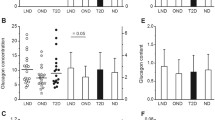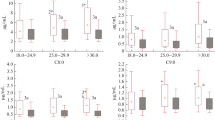Summary
A simple and sensitive human proinsulin radioimmunoassay system was developed using guinea pig antiproinsulin serum, which cross-reacted neither with human insulin nor C-peptide. The recognition site of the antiserum seems to be located near the junction between the B chain and C-peptide. With this assay system, we studied the serum proinsulin concentration at fasting and after an oral 100 g glucose load in 25 healthy subjects, 21 subjects with impaired glucose tolerance and 40 patients with Type 2 (non-insulin-dependent) diabetes mellitus. At fasting, serum proinsulin was 5.8±3.3 pmol/l in normal subjects as compared to 9.5±6.9 pmol/l (p<0.05) in subjects with impaired glucose tolerance and 12.6±7.5 pmol/l (p<0.001) in diabetic patients. The molar ratio of proinsulin to insulin was also increased in subjects with impaired glucose tolerance or diabetes compared to control subjects. After a 100 g oral glucose load, serum proinsulin increased more slowly than insulin. The proinsulin response after an oral glucose load was augmented in subjects with impaired glucose tolerance and diabetes, while the insulin response decreased with the elevation of fasting plasma glucose. Diabetic patients with high fasting plasma glucose had a very poor insulin response, but the proinsulin response was similar to control subjects. There was a linear correlation between summed proinsulin values and summed insulin values, but the slope of the regression line was steeper in diabetic patients than in control subjects. There was a relative increase in serum proinsulin both in subjects with impaired glucose tolerance and diabetic patients. We suggest that B cells may release ‘immature’ granules richer in proinsulin content as well as mature granules in the over-stimulated state.
Similar content being viewed by others
References
Melani F, Rubenstein AH, Steiner DF (1979) Human serum proinsulin. J Clin Invest 49: 497–507
Kemmler W, Steiner DF (1970) Conversion of proinsulin to insulin in subcellular fraction from rat islets. Biochem Biophys Res Commun 41: 1223–1230
Gorden P, Hendricks CM, Roth J (1974) Circulating proinsulin-like compornent in man: increased proportion in hypoinsulinemic states. Diabetologia 10: 469–474
Mako ME, Starr JI, Rubenstein AH (1977) Circulating proinsulin in patients with maturity onset diabetes. Am J Med 63: 865–869
Rastogi GK, Sinha MK, Dash RJ (1973) Insulin and proinsulin content of pancreas from diabetic and non-diabetic subjects. Diabetes 22: 804–807
Alseuer RN, Roberts JP, Gerver JG, Mako ME, Rubenstein AH (1975) Insulinoma with low circulating insulin levels: the diagnostic value of proinsulin measurements. Ann Intern Med 82: 347–350
Fajans SS, Floyd JC Jr (1979) Diagnosis and medical management of insulinomas. Ann Rev Med 30: 313–329
Melani F, Rubenstein AH, Oyer PE, Steiner DF (1970) Identification of proinsulin and C-peptide in human serum by a specific immunoassay. Proc Natl Acad Sci USA 67: 148–156
Kitabchi AD, Duckworth WC, Brush JS, Heinemann M (1971) Direct measurement of proinsulin in human plasma by the use of an insulin degrading enzyme. J Clin Invest 50: 1792–1799
Heding LG (1977) Specific and direct radioimmunoassay for human proinsulin in serum. Diabetologia 13: 467–479
Hartling SG, Dinesen B, Kappelgard A-M, Faber OK, Binder C (1986) ELISA for human proinsulin. Clin Chim Acta 156: 298–298
Cohen RM, Nakabayashi T, Blix PM, Rue PA, Shoelson SE, Root MA, Frank BH, Revens RR, Rubenstein AH (1985) a radioimmunoassay for circulating human proinsulin. Diabetes 34: 84–91
Deacon CF, Conlon JM (1985) Measurement of circulating human proinsulin concentration using a proinsulin-specific antiserum. Diabetes 34: 491–497
Duckworth WC, Kitabchi AE, Heinemann M (1972) Direct measurement of plasma proinsulin in normal and diabetic subjects. Am J Med 53: 418–427
Cohen RM, Given BD, Licinio-Paixao J, Provow SA, Rue PA, Frank BH, Root MR, Plonski KS, Tager HS, Rubenstein AH (1986) Proinsulin radioimmunoassay in the evaluation of insulinomas and familial hyperproinsulinemia. Metabolism 35: 1137–1146
Given BD, Cohen RM, Shoelson SE, Frank BH, Rubenstein AH, Tager HS (1985) Biochemical and clinical implications of proinsulin conversion intermediates. J Clin Invest 76: 1398–1405
Gray IP, Siddle K, Docherty K, Frank BH, Hales CN (1984) Proinsulin in human serum: problems in measurement and interpretation. Clin Endocrinol 21: 43–47
Starr JI, Rubenstein AH (1974) Metabolism of endogenous proinsulin and insulin in man. J Clin Endocrinol Metab 38: 305–308
Gold G, Grodsky GM (1984) Kinetic aspects of compartmental storage and secretion of insulin and zinc. Experientia 40: 1105–1114
Bergenstal RM, Cohen RM, Lever E, Polonsky K, Jaspan J, Blix PM, Revers R, Olefsky JM, Koleterman O, Steiner K, Cherrington A, Frank B, Galloway J, Rubenstein AH (1984) The metabolic effects of biosynthetic human proinsulin in individuals with type 1 diabetes. J Clin Endocrinol Metab 58: 973–979
Author information
Authors and Affiliations
Rights and permissions
About this article
Cite this article
Yoshioka, N., Kuzuya, T., Matsuda, A. et al. Serum proinsulin levels at fasting and after oral glucose load in patients with Type 2 (non-insulin-dependent) diabetes mellitus. Diabetologia 31, 355–360 (1988). https://doi.org/10.1007/BF02341503
Received:
Revised:
Issue Date:
DOI: https://doi.org/10.1007/BF02341503




